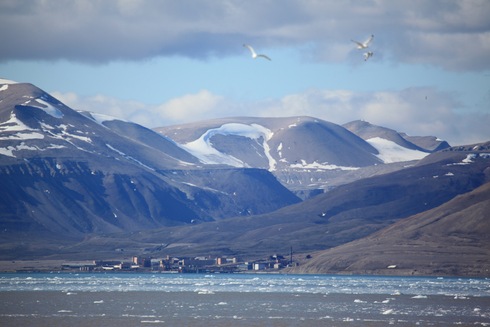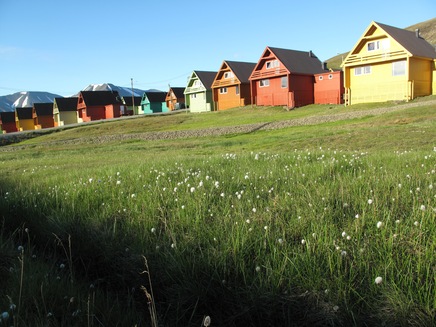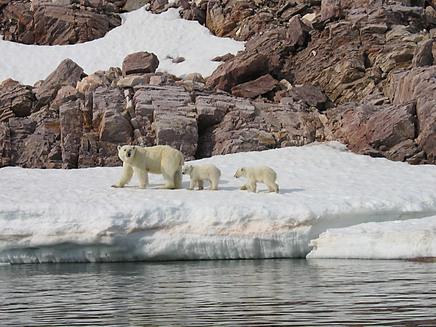Longyearbyen, the world's northern-most town, is not just suffused in charm; it is fully equipped to grant you quick access to the Arctic's delights.
Svalbard, a scrum of islands lying between Norway and the North Pole, wasn't a place I could point out on the map until I began looking for the Arctic equivalent of my rich Antarctic experience. A little research pointed me in its direction and it was midsummer when my friend and I, lured by the promise of sorcerers' vistas and a gathering of wildlife, made our way up, discovering much more than we'd hoped for.
A three hour flight due north from Oslo brought us to Longyearbyen, a pocket-sized town on the island of Spitsbergen. Flanked by over-powering, jagged mountains, a curvy, deep fjord was its umbilical cord to the Greenland Sea.
Giant glaciers cradled in higher ranges, but the snow had dwindled to vertical licks on bare, brown hillsides. This landscape had the promise of white-mist rainbows, the threat of squalls, and a raw, elemental, edge-of the earth feel.
As we were a good deal north of the Tundra, there wasn't a bush or tree in sight. Melting snow revealed slopes of mosses, lichens, grass and flowers no taller than six inches. Even so, the hills and meadows were alive with herds of reindeer, and the arctic foxes and ptarmigans had cleverly switched to their summer camouflage. A couple we befriended had spotted pods of ghostly white beluga whales from their waterfront campsite.
In earlier centuries, only hardy fur-trappers, whalers and coal miners made the journey here, but now wildlife lovers, photographers, adventurers and researchers come to Longyearbyen. It is also the launchpad for Arctic cruises in the summer.
Small as it is, the town displays a strong and confident sense of style with rows of wooden houses painted in fetching colors such as red, lavender and ochre. They look cozy and inviting. Reindeer horns adorn the entrances the sealskins cover the seats and floors. Polar bear pelts are commonly used as wall décor and you realize they're far easier to come by than paintings. Skis hang on the front porch and a line-up of snowmobiles outside speaks of the long winter months when they are the dominant mode of transport. The locals don't fear the winter; they find it liberating. With the first good snow and freezing temperatures comes the freedom to connect to other settlements and traverse the land and frozen rivers in almost any direction.
Polar Bears outnumber humans two to one, and the local residents are required to carry a gun for safety when they leave the town center. A sign outside a shop read, "Leave your skis and guns here," and our trek leaders and guides in the mining towns always bore rifles.
Over the next few days, we did an arduous trek across Foxfonna glacier, collected fossils, went on husky sleigh rides, and spent the evenings in the town's surprisingly lively bars, and restaurants serving delicious arctic char, reindeer and salmon. Our bijoux lodge, the Basecamp Trapper's Hotel, is a driftwood and sealskin affair with a glass-topped attic where the serene tenderness of the midnight sun allowed us to read late into the small hours or just lie back and watch the gulls' exultant acrobatics.
We took a couple of day-cruises to the two mining towns still owned by the Russians. The scenic route brought us right against the blue light that often remains trapped in the glacier ice and we had the entire horizon to ourselves. Ringed seals flounced playfully at the water's edge and on the high, moss covered cliffs, a confetti of birds swirled close to their nests. Masses of sea and birdlife migrate up here in the summer months, drawn by the plentiful fish feeding on the biomass churned up by the meeting of the hot and cold currents. We observed guillemots, gulls and kittiwakes surging, feeding, and raising their chicks, seeming to relish their own raucousness. Arctic terns had flown here all the way from Antarctica. The puffins in the water had become so fat from gorging on fish that they barely got out of the way of our ferry. We shared the seas with humpbacks and orcas, while fulmars circled close, searching for scraps.
The most thrilling sighting by far was a female polar bear and her two cubs on a rocky promontory. They watched our approaching ferry with curiosity. As we came close, the cubs relaxed, going about their business; play-fighting, watching the seals in the water, peering over precipitous edges and reversing in fear. Their mother coaxed them to follow and eventually they did, slowly heading up the hill and away.
The joys of the arctic need not be tethered to a cruise or the tyranny of set dates, and, as it turned out, an island that seemed like it was falling off the map was the center of all the action.
Ways and means
How to get there: Fly to Norway's capital Oslo, then take a direct SAS flight (or connect via Tromso) to Longyearbyen.
Best time to go: May through July to enjoy the midnight sun, to hike, sail and see a vast gathering of sea and bird life. This is also the time when the sea ice melts and the cruise ships can operate.
March through April is the best time to drive snowmobiles and track polar bears.
Stay at: The atmospheric Basecamp Trapper's Hotel has 16 rooms with a Nordic feel. http://www.basecampexplorer.com and their travel arm can help plan your itinerary.
Radisson Blu Polar Hotel is larger and offers basic accommodation with a good dining experience.
Eat at: Kroa, next to Basecamp Trapper's Lodge serves Nordic cuisine and is very popular.
Huset, a bit further afield, offers fine dining in a house-like setting.
Drink at: Barentz Pub, Svalbard and the bar at Radisson Blue hotel.


